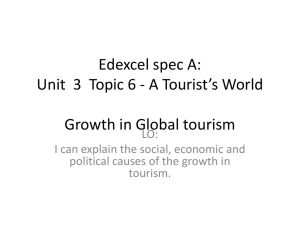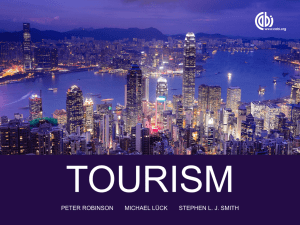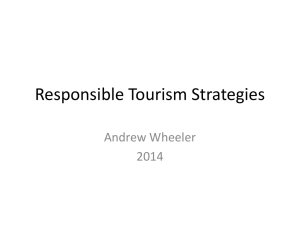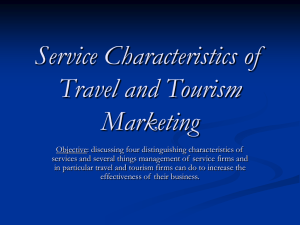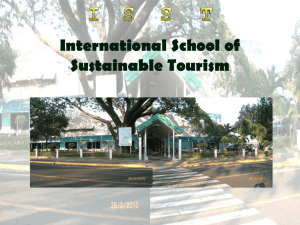The History of Tourism
advertisement
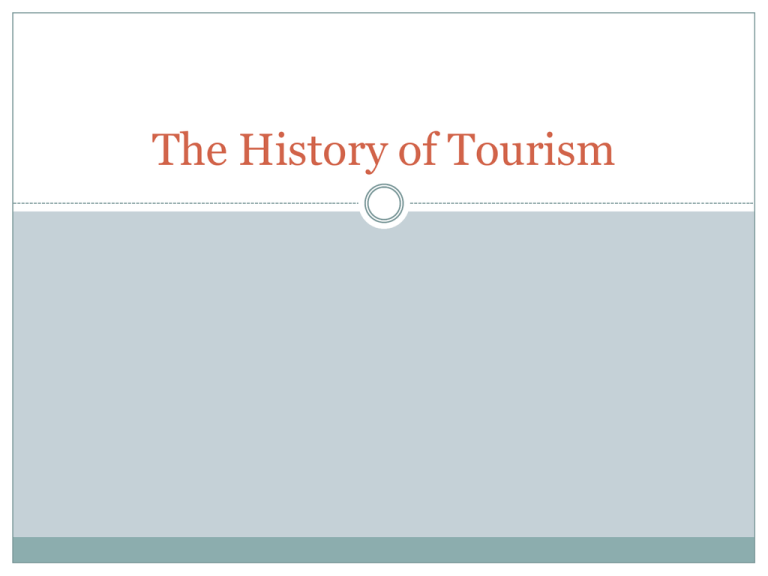
The History of Tourism Early Tourism Tourism is derived from the Hebrew word torah which means studying, learning, searching. Early tourism has two forms: Travel for business Religious travel The invention of money, writing and wheel by the Sumerians facilitated travel and exchange of goods. The early Phoenicians toured the Mediterranean as traders. Both the Greeks and the Romans were well-known traders and as their respective empires increased, travel became necessary. At this time, there was also travel for private purposes. Travel for religious reason took the form of pilgrimages to places of worship . Pilgrimages were made to fulfill a vow as in case of illness or of great danger or as penance for sins. Beside Rome and Jerusalem, St. James of Galicia was the foremost destination of English pilgrims in the 14th century. Beginning in 1388, English pilgrims were required to obtain and carry permits, the forerunner of the modern passport. Tourism in the Medieval Period During the medieval period, travel declined. Travel, derived from the word travail, became burdensome, dangerous and demanding during this time. After the decline of the Roman Empire in the 5th century, roads were not maintained and they became unsafe. Thieves infected harm on those who dared to travel. No one during this time travelled for pleasure. Crusaders and pilgrims were the only ones who traveled. Tourism During the Renaissance and Elizabethan Eras Because few renowned universities developed, traveling for education was introduced by the British in the 16th century. Under Elizabeth I, young men seeking positions in court were encouraged to travel to the Continent to widen their education. This practice was gradually adopted by others in the lower social scale. In time it became recognized that the education of a gentleman should be completed by a “Grand Tour” of the cultural centers of the Continent which lasted for three years. Typical Grand Tourist Map of Grand Tour Grand Tour was used as early as 1670. While apparently educational, the appeal became social. Pleasure-seeking young men of leisure travelled predominantly through France and Italy . By the end of the 18th century, the practice had become institutionalized for the upper class of society. As young men sought intellectual improvement in the Continent, the sick sought a remedy for their illnesses in “spas” or medicinal baths. The term “spa” is derived from the word Waloon word “espa” meaning fountain. Travelers immersed themselves in healing waters, soon, entertainment was added, and dozens of watering places became resort hotels. Tourism during the Industrial Revolution The Industrial Revolution brought about major changes in the scale and type of tourism development. It brought about not only technological changes but also essential social changes that made travel desirable as a recreational activity. The increase in productivity, regular employment, and growing urbanization gave more people the motivation and opportunity to go on holiday . The emerging middle class combined higher incomes and growing education into annual holidays. To escape from their responsibilities and the crowded city environment, they traveled to the countryside or seashore for their holidays. This led to the creation of working class resorts near major industrial centers. Tourism in the 19th Century Two technological developments in the early part of the 19th century had a great effect on the growth of tourism. Introduction of the railway Development of steam power The railways created not only more business by proving reliable and cheap transportation, but also more competition as various private companies invested heavily in hotels, resorts and entertainment facilities. Thus, tourism was transformed from a small business catering to the elite into the start of a mass market, that is, travel by a large number of individuals. The use of steam power provided the increased mobility needed by the tourism business. Steamers on the major rivers provided reliable and inexpensive transportation that led to the popular day-trip cruises and the growth of coastal resorts near large industrial towns. As tourism became organized in the later years of the 19th century, the organization of travel became an established institution. Travel organizers emerged. The first and most famous of these was Thomas Cook. His first excursion train trip was between Leicester and Loughborough in 1841 with 570 passengers at a round-trip fare of one shilling. The success of this venture encouraged him to arrange similar excursions using chartered trains. In 1866 he organized his first American tour. In 1874, he introduced “circular notes” which were accepted by banks, hotels, shops, and restaurants. These in effect the first traveler’s checks. Other tour companies in Britain: Dean and Dawson in 1871 Polytechnic Touring Association in 1872 Frames in 1881 In the United States, American Express was founded by Henry Wells and William Fargo As the 19th century drew to a close, photography and guide-books became popular. A huge variety of guide-books which dealt with both local and overseas travel were sold to tourists. The most popular of these was Baedecker, first published in 1839, which became the leading guide for European countries at the end of the century.

